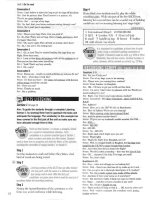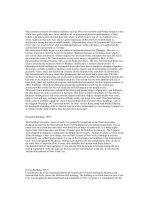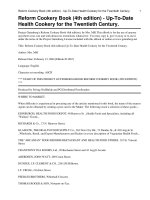Step Up to MRCP Review Notes for P1 & P2 By Dr Khaled El Magraby 1st ed 2015
Bạn đang xem bản rút gọn của tài liệu. Xem và tải ngay bản đầy đủ của tài liệu tại đây (9.02 MB, 1,283 trang )
Step Up
To
MRCP
Review Note
For
Part I & Part II
By
Dr Khaled El Magraby
Dr Khaled Magraby MRCP Notes
بسم هللا الرحمن الرحيم
صدق هللا العظيم
سورة البقرة ۩ اﻵية { } ٣٢
Dr Khaled Magraby MRCP Notes
Introduction
First of all, I would like to thank ALLAH, the most Merciful and
Compassionate.
Words can never express my sincere thanks to my parents for everything
throughout my life from K.G till MRCP and their prayers, encouragement, love,
endless care and spiritual support when I was in most need of it; that can never be
sufficiently acknowledged.
I pray to ALLAH to make this work of benefit to the all doctors would like to
have MRCP by giving them the important pearls of Internal medicine and to accept
our honest intention in this work.
It is a very helpful and important source for preparation and studying MRCP
examination for both part 1 and 2.
It is very rich in information from many sources:
www.passmedicine.com
www.onexamination.com
www.pasTest.co.uk
1st edition @ September 2015
Dr Khaled Magraby MRCP Notes
دكتور خالد المغربي
أخصائى األمراض الباطنة والكلى
ماجيستير األمراض الباطنة
كلية طب قصر العينى – جامعة القاهرة
باحث مساعد بالمركز القومى للبحوث
Dr Khaled El Magraby
Specialist of Internal Medicine & Nephrology
M.Sc. Internal Medicine
Cairo University, Egypt
Assistant Researcher
National Research Center, Egypt
E-mail:
Facebook: Khaled Elmagraby
00966565084114 (WhatsApp & LINE)
00201223355396
Dr Khaled Magraby MRCP Notes
TABLE OF THE CONTENTS
Subject
Page
Chapter 1: Cardiology…………………………………….……………….…..….
1
Chapter 2: Pulmonology……………………………..…………………….……..
147
Chapter 3: Gastroenterology & Hepatology …………………………..……...
239
Chapter 4: Endocrinology …………………..…………………….…………..…
341
Chapter 5: Haematology……………………………………………………..…...
473
Chapter 6: Nephrology………………………..……………………..……...…….
599
Chapter 7: Rheumatology .............................................................................
670
Chapter 8: Pharmaceuticals & Therapeutics………….…..………………….
762
Chapter 9: Infectious Diseases & STDs……………………………………..…
843
Chapter 10: Neurology...................................................................................
946
Chapter 11: Psychiatry...................................................................................
1054
Chapter 12: Ophthalmology……………..……………..……………….…….…
1084
Chapter 13: Dermatology………………………………………….…..………….
1112
Chapter 14: Basic Sciences, Biostatistics & Miscellaneous ……...…....…
1158
Dr Khaled Magraby MRCP Notes
Chapter 1: Cardiology
Cardiology
Dr Khaled Magraby MRCP Notes
Chapter 1: Cardiology
Long QT syndrome (LQTS)
LQTS is an inherited condition associated with delayed repolarization of the
ventricles.
It is important to recognise as it may lead to ventricular tachycardia (VT) and can
therefore cause collapse/sudden death.
The most common variants of LQTS (LQT1 & LQT2) are caused by defects in the
alpha subunit of the slow delayed rectifier potassium channel.
A normal corrected QT interval is less than 430 ms (0.43 Sec.) in males and 450
ms (0.45 Sec.) in females.
Normal range for duration of the corrected QT interval (QTc) is 350 -430 ms
Causes of a prolonged QT interval:
Congenital:
Jervell-LangeNielsen (JLN)
syndrome:
(includes
deafness and is
due to an
abnormal
potassium
channel)
Romano-Ward
syndrome: (no
deafness)
Drugs:
Amiodarone
Sotalol
Class 1a
antiarrhythmic
drugs.
TCA (e.g.
amitriptyline) (˃
SSRI)
SSRI (especially
citalopram,
Sertraline).
Lithium
Methadone
Chloroquine
Mefloquine
Terfenadine
Macrolides:
Erythromycin,
Clarithromycin
Levofloxacin
Domperidone
Ketoconazole
Haloperidol
Tacrolimus
Dr Khaled Magraby MRCP Notes
Others:
Electrolyte:
Hypocalcaemia,
Hypokalaemia,
Hypomagnesaemia
Acute MI.
Myocarditis.
HOCM
Hypothermia.
Subarachnoid
haemorrhage.
Hypothyroidism
Cardiology
1
Chapter 1: Cardiology
Jervell - Lange-Nielsen (JLN) syndrome is caused by mutations in the KCNE1
and KCNQ1 genes.
The KCNE1 and KCNQ1 genes provide instructions for making proteins that work
together to form a channel across cell membranes. These channels transport
positively charged potassium atoms (ions) out of cells. The movement of potassium
ions through these channels is critical for maintaining the normal functions of inner
ear structures and cardiac muscle.
Features:
May be picked up on routine ECG or following family screening.
Long QT1 - usually associated with exertional syncope, often swimming.
Long QT2 - often associated with syncope occurring following emotional
stress, exercise or auditory stimuli e.g. doorbell or telephone ring.
Long QT3 - events often occur at night or at rest.
Sudden cardiac death.
Diagnosis is based upon the QTc (corrected QT interval), although this may
be within the normal range at rest; hence Holter ECG monitoring is
recommended.
Identification of an LQTS genetic mutation confirms the diagnosis. However,
a negative result on genetic testing is of limited diagnostic value because only
approximately 50% of patients with LQTS have known mutations. The
remaining half of patients with LQTS may have mutations of yet unknown
gene.
Therefore genetic testing of LQTS has high specificity but a low sensitivity.
The ECG shows a long QT and ventricular premature beats. The loss of
consciousness may have been due to ventricular arrhythmia, in particular, torsade
de pointes VT.
Dr Khaled Magraby MRCP Notes
Cardiology
2
Chapter 1: Cardiology
Management (by order): بالترتيب
Avoid drugs which prolong the QT interval and other precipitants if
appropriate (e.g. Strenuous exercise).
2) Beta-blockers (e.g. Propranolol, Metoprolol & Atenolol, NOT Sotalol).
3) ICD (Implantable cardioverter defibrillators) in high risk cases (i.e. It is only
required in high risk cases, for example if the patient has a QTc > 500ms or
previous episodes of cardiac arrest.
4) Left stellate cardiac ganglionectomy.
1)
Long QT syn. >> usually due to loss-of-function/blockage of K+ channels.
NB: Beta blockers are the mainstay of therapy for asymptomatic as well as
symptomatic patients with idiopathic LQTS.
Beta blockers decrease sympathetic activation from the left stellate ganglion, also
decrease the maximal heart rate achieved during exertion and thereby prevent
exercise-related arrhythmic events that occur in LQTS.
Patients who experience ventricular arrhythmias or aborted SCD despite beta
blocker therapy >>> should have an ICD in addition to βB.
Left stellate cardiac ganglionectomy is an invasive procedure and results in
Horner’s syndrome. It is performed in patients who have symptoms despite βB and
have frequent shocks with ICD.
NB: Non-sedating antihistamine and classic cause of prolonged QT in a patient,
especially if also taking P450 enzyme inhibitor, e.g. Patient with a cold takes
terfenadine and erythromycin at the same time.
NB: Sotalol may exacerbate long QT syndrome (due to blockage of K channel) it
leads to a risk of ventricular arrhythmias. This can be a particular risk in individuals
with hypokalaemia. So Sotalol is better to be avoided in patients with thiazide
diuretics.
EX: A 75-year-old man with a history of anterior MI is taking amiodarone 400 mg/day
for history of VT. He has a prolonged QTc interval on his ECG of 550 ms. The most
appropriate management >>> Stop amiodarone immediately and can replace
with atenolol 50 mg a day.
Dr Khaled Magraby MRCP Notes
Cardiology
3
Chapter 1: Cardiology
Management of drug-induced LQTS is:
1) Stop precipitating drugs.
2) Correction of any electrolyte disturbance like hypo K or Mg.
3) TTT of associated ventricular arrhythmia: first line for drug-induced LQTS is IV
MgSO4 2 gm as bolus over 1-2 minutes, followed by another bolus in 15
minutes if required, or continuous infusion at a rate of 5-20 mg/min.
QT shortening: caused by: >>> Hypercalcaemia, Hypermagnesaemia, Digoxin,
or Thyrotoxicosis.
Torsade’s de pointes
Torsade’s de pointes ('twisting of the points') is a rare arrhythmia associated with a
long QT interval.
It may deteriorate into ventricular fibrillation and hence lead to sudden death.
Causes of long QT interval: (see before)
Risk factors: female sex, prolonged QT interval, bradycardia, hypokalaemia,
severe hypomagnesaemia, severe alkalosis, CHF, digitalis toxicity, recent
conversion from AF.
Management: IV MgSo4 (Magnesium Sulphate)
MgSo4 >>> it decreases Ca influx, reducing the amplitude of the VT and helping
terminate runs of torsade’s. It is effective even when serum magnesium level is
normal.
Ventricular tachycardia (VT): management
Whilst a broad complex tachycardia may result from a supraventricular rhythm with
aberrant conduction, the European Resuscitation Council advise that in a peri-arrest
situation it is assumed to be ventricular in origin.
VT is broad-complex tachycardia originating from a ventricular ectopic focus.
It has the potential to precipitate ventricular fibrillation and hence requires urgent
treatment.
There are two main types of VT:
Monomorphic VT: most commonly caused by myocardial infarction.
Dr Khaled Magraby MRCP Notes
Cardiology
4
Chapter 1: Cardiology
Polymorphic VT: A subtype of polymorphic VT is torsade’s de pointes which is
precipitated by prolongation of the QT interval.
Management:
If the patient has adverse signs (systolic BP < 90 mmHg, chest pain, heart failure or
rate > 150 beats/min) then immediate cardioversion is indicated.
In the absence of such signs antiarrhythmics may be used. If these fail, then
electrical cardioversion may be needed with synchronised DC shocks.
VT with pulse (not respond to medical ttt) >>> cardioversion (synchronized)
Pulseless VT or VF >>> DC (asynchronized)
Drug therapy:
Amiodarone: ideally administered through a central line (300 mg over the first
hour then 900 over the next 23 hours).
2) Lidocaine: use with caution in severe left ventricular impairment as it is
negative inotropic drug.
3) Procainamide.
1)
NB: Verapamil should NOT be used in VT.
If drug therapy fails:
Electrophysiological study (EPS).
Implantable cardioverter-defibrillator (ICD) - this is particularly indicated in
patients with significantly impaired LV function.
NB: Hypokalaemia is the most important cause of ventricular tachycardia (VT)
clinically, followed by hypomagnesaemia.
Severe hyperkalaemia may cause VT in certain circumstances, for example in
patients with structural heart disease, but it is not as common a cause as
hypomagnesaemia.
The 2010 ALS guidelines state that if a patient has a monitored and witnessed
VF/pulseless VT arrest in hospital, three quick successive (stacked) shocks 200
J should be given. Chest compressions should be started immediately after the
third, with a compression to ventilation ratio of 30:2 for 2 minutes.
Dr Khaled Magraby MRCP Notes
Cardiology
5
Chapter 1: Cardiology
A precordial thump can be successful if given within seconds of the onset of a
shockable rhythm. Delivery should not delay calling for help, or accessing a
defibrillator, but would be indicated here whilst awaiting the defibrillator. Chest
compressions should start immediately if it is unsuccessful.
Adrenaline IV would be given every 3-5 minutes once chest compressions had
started.
Defibrillation for three times.
If defibrillated for the third time without return of cardiac output. CPR is immediately
resumed and adrenaline administered.
The next step is amiodarone 300 mg intravenously (i.e. given after the third
shock). If amiodarone is not available lidocaine is a suitable alternative.
NB: New guideline, there is no need for the 3 successive shocks, only one shock
followed by immediate chest compression and then reassess the pulse and rhythm
after finish of the cycle of 2 minutes.
NB: Pulseless VT with severe hypothermia >>> DC shock or medication will be
ineffective, so better to start with prolonged CPR firstly till temperature can reach
˃ 30º. تدفئة المريض هامة جدا فى الكود بلو
Hypothermic patients do not respond well to shocks or drugs and if there is no
response to the first three shocks the patient should be rewarmed to at least 32°C
before any drugs or shocks are administered.
NB: PVC to be significant, they have to meet the following criteria:
1)
2)
3)
4)
5)
Frequency ≥ 6 bpm.
PVC in bigeminal or trigeminal rhythm.
PVC in short runs of VT
PVC exhibiting R on T phenomenon.
PVC associated with serious organic
decompensation.
Dr Khaled Magraby MRCP Notes
heart
disease
and
Cardiology
LV
6
Chapter 1: Cardiology
Cardiac enzymes and protein markers:
Key points for the exam:
Myoglobin is the first to rise as early as 1 hr of MI (within first 2 hrs), peak in
6-8 hrs and return to normal in 24 hr.
CK-MB is useful to look for re-infarction as it returns to normal after 2-3 days
(troponin T remains elevated for up to 10 days).
GPBB (Glycogen phosphorylase isoenzyme BB): is an isoenzyme of
glycogen phosphorylase which exists in cardiac muscle. By three hours post
myocardial infarction it has risen significantly. As such it is an
appropriate marker for early cardiac muscle injury.
Begins to
rise
Peak
value
Returns to
normal
Myoglobin
1-2 hours
6-8 hours
1-2 days
CK-MB
2-6 hours
16-20
hours
2-3 days
CK
4-8 hours
16-24
hours
3-4 days
Trop T
4-6 hours
12-24
hours
7-10 days
AST
12-24 hours
36-48
hours
3-4 days
LDH
24-48 hours
72 hours
8-10 days
Troponin is a component of the thin filaments (along with actin and
tropomyosin), and is the protein to which calcium binds to accomplish this
regulation.
Dr Khaled Magraby MRCP Notes
Cardiology
7
Chapter 1: Cardiology
The other components of thin filaments are actin and tropomyosin.
Thick filaments are primarily composed of myosin.
Troponin has three subunits, TnC, TnI, and TnT.
When calcium is bound to specific sites on TnC, the structure of the thin filament
changes in such a manner that myosin (a molecular motor organised in muscle thick
filaments) attaches to thin filaments and produces force and/or movement.
In the absence of calcium, tropomyosin interferes with this action of myosin, and
therefore muscles remain relaxed.
Troponin T bind to Tropomyosin which is a protein which regulates actin. It
associates with actin in muscle fibres and regulates muscle contraction by regulating
the binding of myosin.
Troponin assay at 3 and 6 hours is adequate to determine whether myocardial
damage has occurred.
Causes of an elevated troponin are:
Trauma
Cardioversion
Rhabdomyolysis
Pulmonary embolism
Pulmonary hypertension
Hypertension
Hypotension, especially with arrhythmias
HOCM
Myocarditis including Kawasaki's disease
Sepsis
Burns
Subarachnoid haemorrhage and stroke
Infiltrative/autoimmune disorders: including sarcoidosis, amyloidosis,
haemochromatosis and scleroderma.
Drugs: including Adriamycin, Herceptin and 5-fluorouracil.
HOCM (Hypertrophic Obstructive Cardiomyopathy)
HOCM is an autosomal dominant disorder of muscle tissue caused by
defects in the genes encoding contractile proteins.
The most common defects involve a mutation in the gene encoding β-myosin
heavy chain protein or myosin binding protein C.
Dr Khaled Magraby MRCP Notes
Cardiology
8
Chapter 1: Cardiology
Mutations to various proteins including alpha-tropomyosin and troponin T
have been identified.
The estimated prevalence is 1 in 500.
HOCM is the most common cause of sudden cardiac death in the young.
The history of sudden arrhythmia and death in a young, previously well, individual
is suggestive of HOCM. Relatives should be screened for it.
Features:
Often asymptomatic
Dyspnoea, angina, syncope, palpitation
Sudden death (commonly due to vent. arrhythmias ≥), heart failure
Jerky pulse, large 'a' waves,
Double apex beat
Ejection systolic murmur: ↑ with Valsalva manoeuvre & ↓ on squatting.
Associations:
Friedreich's ataxia
Wolff-Parkinson White
Echo - mnemonic - MR SAM ASH
Mitral regurgitation (MR)
Systolic anterior motion (SAM) of the anterior mitral valve leaflet
Asymmetric hypertrophy (ASH): concentric hypertrophy (undilated) LV
(increased septal versus LV wall diameter of ratio of > 1.3:1).
ECG:
RBBB,
Prolonged PR,
Non-specific T wave abnormalities.
LVH
Deep Q waves in anterolateral and inferior leads
AF may occasionally be seen
Cardiac catheterisation:
Left ventricular pressures are high (210/15) with a steep drop-off between the LV
and aortic systolic pressures (125/75).
Dr Khaled Magraby MRCP Notes
Cardiology
9
Chapter 1: Cardiology
Poor prognostic factors (6):
1)
2)
3)
4)
5)
6)
Syncope.
Young age at presentation.
Family history of HOCM and sudden death.
Non-sustained ventricular tachycardia on 24 or 48-hr Holter monitoring.
Abnormal blood pressure changes on exercise (drop of BP during peak
exercise on stress testing).
An increased septal wall thickness ˃ 3 cm: Septal hypertrophy causes left
ventricular outflow (LVOT) obstruction. It is an important cause of sudden
death in apparently healthy individuals.
Management (ABCDE):
1)
2)
3)
4)
5)
Amiodarone
Beta-blockers
Cardioverter defibrillator (ICD)
Dual chamber pacemaker
Endocarditis prophylaxis*
N.B: Reducing outflow tract obstruction with myomectomy or alcohol septal ablation
does not reduce the risk of SCD, but it is usually recommended especially when the
outflow gradient is greater than 50 mmHg particularly if symptoms of
dyspnoea persist post β blockade.
Drugs to avoid:
Nitrates
ACE-inhibitors
Inotropes
NB: Verapamil should however be avoided in HOCM patients with coexistent WolffParkinson White as it may precipitate VT or VF.
NB: Most cardiologists would now proceed to inserting an implantable cardioverter
defibrillator (ICD) to lower the risk of sudden cardiac death (SCD).
EX: Pt. HOCM with palpitations >>> a 24 hour ECG reveals >>> runs of nonsustained VT >>> best ttt is ICD.
NB: The most common causes of sudden cardiac death (SCD):
HOCM is a more common cause of sudden cardiac death than
arrhythmogenic right ventricular dysplasia (ARVD). The estimated prevalence
is 1 in 500.
Dr Khaled Magraby MRCP Notes
Cardiology
10
Chapter 1: Cardiology
ARVC (Arrhythmogenic right ventricular cardiomyopathy): the second most
common cause of sudden cardiac death in the young after HOCM.
CPVT (Catecholaminergic polymorphic ventricular tachycardia) is a form of
inherited cardiac disease. It is inherited in an autosomal dominant fashion
and has a prevalence of around 1:10,000.
Brugada syndrome is a form of inherited cardiovascular disease. It is
inherited in an autosomal dominant fashion and has an estimated prevalence
of 1:5,000-10,000. Brugada syndrome is more common in Asians.
Screening of HOCM:
Current guidelines suggest that a resting ECG and TTE (transthoracic ECHO) are
the most effective screening strategies for relatives of patients with HOCM.
Genetic testing is not recommended as a first line screening tool given varying rates
of penetrance.
Arrhythmogenic right ventricular cardiomyopathy (ARVC)
It is a form of inherited CV disease which may present with syncope or SCD.
It is generally regarded as the second most common cause of sudden cardiac death
in the young after HOCM.
Pathophysiology:
Inherited in an autosomal dominant pattern with variable expression
The right ventricular myocardium is replaced by fibrofatty tissue
Presentation:
Palpitations
Syncope
Sudden cardiac death
Investigation:
ECG abnormalities in V1-3, typically T wave inversion. An epsilon wave is
found in about 50% of those with ARVC - this is best described as a terminal
notch at the end of QRS complex.
Dr Khaled Magraby MRCP Notes
Cardiology
11
Chapter 1: Cardiology
Echo changes are often subtle in the early stages but may show an enlarged,
hypokinetic right ventricle with a thin free wall.
MRI is useful to show fibrofatty tissue.
Management:
Beta-blockers: sotalol is the most widely used antiarrhythmic
Catheter ablation to prevent ventricular tachycardia
Implantable cardioverter-defibrillator
NB: Naxos disease:
An autosomal recessive variant of ARVC
A triad of ARVC + palmo-plantar keratosis+ and woolly hair.
Catecholaminergic polymorphic ventricular tachycardia (CPVT)
CPVT is a form of inherited cardiac disease associated with SCD.
It is inherited in an autosomal dominant fashion and has a prevalence of around
1:10,000.
Pathophysiology:
The most common cause is a defect in the ryanodine receptor (RYR2) which
is found in the myocardial sarcoplasmic reticulum.
Features:
Exercise or emotion induced polymorphic ventricular tachycardia resulting in
syncope.
Sudden cardiac death.
Symptoms generally develop before the age of 20 years.
Management:
Beta-blockers
Implantable cardioverter-defibrillator (ICD).
Dr Khaled Magraby MRCP Notes
Cardiology
12
Chapter 1: Cardiology
Brugada syndrome (Br S) (Brugada et al., 1992)
Brugada syndrome is a form of inherited cardiovascular disease with may present
with sudden cardiac death.
It is inherited in an autosomal dominant fashion and has an estimated prevalence of
1:5,000-10,000.
Brugada syndrome is more common in Asians.
Pathophysiology:
A large number of variants exist.
Around 20-40% of cases are caused by a mutation in the SCN5A gene which
encodes the myocardial sodium ion channel protein.
Usually there are no structural abnormalities in Brugada syndrome patients
and the disease may be defined as a pure electrical abnormality of
myocardial cells (i.e. Normal Echo).
Usually manifests with syncope or SCD occurring in the third or fourth decade
of life and usually at rest or during sleep.
Investigations:
1) ECG changes:
a) Convex ST elevation V1-V3
b) Complete or incomplete right bundle branch block (RBBB)
c) Changes may be more apparent following Flecainide.
2) IV ajmaline with electrophysiological study (EPS) testing.
Management:
No ttt apart from prophylactic insertion of Implantable cardioverter-defibrillator (ICD)
aiming to treat life threating arrhythmia esp. VT.
(A) Normal ECG in the precordial leads V1-3,
Dr Khaled Magraby MRCP Notes
(B) Brugada syndrome (type B).
Cardiology
13
Chapter 1: Cardiology
NB: Brugada syndrome (3 types):
Type
1 has a coved type ST elevation with at least 2 mm (0.2 mV) J-point
elevation a gradually descending ST segment followed by a negative Twave.
Type 2 has a saddle back pattern with a least 2 mm J-point elevation and
at least 1 mm ST elevation with a positive or biphasic T-wave. Type 2
pattern can occasionally be seen in healthy subjects.
Type 3 has either a coved (type 1 like) or a saddle back (type 2 like)
pattern with less than 2 mm J-point elevation and less than 1 mm ST
elevation. Type 3 pattern is not uncommon in healthy subjects.
Hypertension in pregnancy
Women who are at high risk of developing pre-eclampsia should take aspirin 75mg
OD from 12 weeks until the birth of the baby.
High risk groups include:
Hypertensive disease during previous pregnancies
Type 1 or 2 diabetes mellitus
Chronic kidney disease
Autoimmune disorders such as SLE or Antiphospholipid syndrome
The classification of hypertension in pregnancy is complicated and varies.
Remember, in normal pregnancy:
Blood pressure usually falls in the first trimester (particularly the
diastolic), and continues to fall until 20-24 weeks.
After this time the blood pressure usually increases to pre-pregnancy
levels by term.
Dr Khaled Magraby MRCP Notes
Cardiology
14
Chapter 1: Cardiology
The heart rate increases by 10-20 bpm, stroke volume and cardiac output
increase but venous pressure should remain the same due to a 25%
reduction in systemic and pulmonary vascular resistance.
Blood pressure during pregnancy normally falls in first half of pregnancy before rising
to pre-pregnancy levels before term.
Hypertension in pregnancy in usually defined as:
Systolic > 140 mmHg or diastolic > 90 mmHg.
Or an increase above booking readings of > 30 mmHg systolic or > 15
mmHg diastolic.
After establishing that the patient is hypertensive they should be categorised into one
of the following groups:
Pre-existing
hypertension
Pregnancy-induced
hypertension
(PIH),
Pre-eclampsia
(Chronic HTN)
A history of
hypertension
before
pregnancy or an
elevated blood
pressure >
140/90 mmHg
before 20
weeks
gestation.
No proteinuria,
no oedema.
Occurs in 3-5% of
pregnancies and is
more common in older
women.
Dr Khaled Magraby MRCP Notes
also known as
(Gestational
hypertension)
Hypertension (as
Pregnancydefined above)
induced
occurring in the
hypertension
second half of
after 20 wks. in
pregnancy (i.e.
association with
after 20 Wks).
proteinuria
No proteinuria,
(>0.3g / 24
no oedema
hours)
Occurs in around
Oedema may
5-7% of
occur but is now
pregnancies.
less commonly
Resolves
used as a
criteria.
following birth
(typically after
Occurs in around 5% of
one month).
Women with PIH pregnancies.
are at increased
risk of future preeclampsia or
HTN later in life.
Cardiology
15
Chapter 1: Cardiology
NB: Pregnancy related blood pressure problems (such as pregnancy-induced
hypertension or pre-eclampsia) do not occur before 20 weeks.
NB: The raised ambulatory blood pressure readings exclude a diagnosis of whitecoat hypertension.
NB: The target BP in patients with pre-existing hypertension is under 150/100
mmHg, or 140/90 mmHg in the presence of end organ failure.
As in patients with longstanding HTN aggressive BP control may compromise
placental function, so diastolic blood pressure should be preserved < 80 mmHg.
Any increase in BP above baseline should prompt a search for new pre-eclampsia.
Pre-eclampsia:
Pre-eclampsia is a condition seen after 20 weeks gestation characterised by
pregnancy-induced hypertension in association with proteinuria (> 0.3g / 24 hours).
Oedema used to be third element of the classic triad but is now often not included in
the definition as it is not specific.
Pre-eclampsia is defined as:
1)
Condition seen after 20 weeks gestation
2)
Pregnancy-induced hypertension (PIH)
3)
Proteinuria
Pre-eclampsia is important as it predisposes to the following problems:
Fetal: prematurity, intrauterine growth retardation
Eclampsia
Haemorrhage: placental abruption, intra-abdominal, intra-cerebral
Cardiac failure
Multi-organ failure
Risk factors:
1)
2)
3)
4)
5)
6)
7)
8)
9)
> 40 years old
Null parity (or new partner)
Multiple pregnancy (twins)
Pregnancy interval of more than 10 years
BMI > 30 kg/m^2
DM
Family history of pre-eclampsia
Previous history of pre-eclampsia
Pre-existing vascular disease such as hypertension or renal disease
Dr Khaled Magraby MRCP Notes
Cardiology
16
Chapter 1: Cardiology
Some evidences suggest that pre-eclampsia is less common in smokers
Features of severe pre-eclampsia:
Hypertension: typically > 170/110 mmHg
Proteinuria: dipstick ++/+++
Headache
Visual disturbance, Papilledema
Hyperreflexia, clonus
RUQ/epigastric pain
HELLP syndrome: Haemolysis, Elevated Liver enzymes, Low Platelet count
< 100 * 106/l.
Nearly 10% of women with severe preeclampsia and 30-50% of women with
eclampsia are affected by HEELP syndrome.
The exact relationship between HELLP syndrome and Pre-eclampsia is unknown.
One third of women with pre-eclampsia (HELLP) develop DIC or TTP.
Management:
Pre-eclampsia >>> best and definitive ttt is >>> Delivery of the baby.
Patients with chronic hypertension are at increased risk of developing preeclampsia and are therefore prescribed 75 mg of aspirin daily from 12
weeks, which is believed to reduce the risk.
Consensus guidelines recommend treating blood pressure > 160/110 mmHg
although many clinicians have a lower threshold.
Oral / IV labetalol is now first-line following the 2010 NICE guidelines.
Nifedipine, or hydralazine can be used as alternatives after considering sideeffect profiles for the woman, foetus and new-born baby.
Delivery of the baby is the most important and definitive management step.
The timing depends on the individual clinical scenario.
MgSo4 is used peri-delivery to reduce the risk of seizures, and may have
adjunctive effects on lowering BP and would be considered as the potential
next step after BP lowering by IV labetalol. (Firstly Labetalol IVI then MgSo4
IVI).
EX: Pregnant female 35 week with BP 180/130 mmHg, severe headache, blurring of
vision, bilateral LL oedema, bilateral papilledema >>> Next step is firstly IV
labetalol, then MgSo4 IVI peri-delivery.
Dr Khaled Magraby MRCP Notes
Cardiology
17
Chapter 1: Cardiology
Labetalol oral is first line for moderate hypertension in pregnancy, according to
NICE guidance.
[
TTT of HTN in pregnancy:
Safe:
- Labetalol,
- Nifedipine,
- Aldomet (max dose 1 gm BID),
- Hydralazine
Not safe
- ACEI / ARBs (risk of renal agenesis and subsequent fetal death) and
- Diuretics (↓ volume expansion associated during normal pregnancy) are absolutely
contraindicated.
- Atenolol is associated with IUGR and so it is not the first choice beta blocker for
use in pregnancy, in contrast Labetalol is not associated with IUGR.
TTT of hyperemesis:
First line: Promethazine is recommended in the BNF as a potential 1st line ttt.
Alternative include Domperidone and Ondansetron.
Metoclopramide and prochlorperazine are associated with increased risk of acute
dystonia in young women, therefore they are only recommended in guidelines in the
second line position for the ttt of symptoms of hyperemesis.
Dr Khaled Magraby MRCP Notes
Cardiology
18









